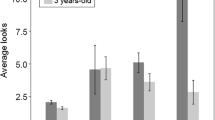Abstract
Adult titi monkeys react to novelty more strongly and cautiously than other New World primates. Developmental changes in responsiveness were assessed by presenting complex novel objects to family groups consisting of 11 male-female pairs and their adult (31–33 months), subadult (20–23 months), and juvenile offspring (10–16 months). Food and a simple block were included as control conditions. Differences in attraction to novel objects were inversely related to age. Juveniles approached more objects, more quickly, and spent more time near them than older subjects. Parents, the least responsive age-group, seemed more indifferent than cautious. Age-effects were smaller with the block, and negligible with food. Even in the most responsive age-group, investigatory behavior appeared subdued as compared to other primate species.
Similar content being viewed by others
References
Andrews, M. W. 1988. Spatial strategies of oriented travel inCallicebus moloch andSaimiri sciureus.Anim. Learn. Behav., 16: 429–435.
Barnett, S. A. 1958. Exploratory behaviour.Brit. J. Psychol., 49: 289–310.
Berlyne, D. E. 1966. Curiosity and exploration.Science, 153: 25–33.
Butler, R. A. 1960. Acquired drives and the curiosity-investigative motives. In:Principles of Comparative Psychology,Waters,R. H.;Rethlingshafer,D. A.;Caldwell,W. E. (eds.), McGraw-Hill, New York, pp. 144–176.
Caine, N. G. 1986. Behavior during puberty and adolescence. In:Comparative Primate Biology, Vol. 2A: Behavior, Conservation, and Ecology,Mitchell,G.;Erwin,J. (eds.), Alan R. Liss, New York, pp. 327–361.
Dennis, W. 1955. Early recognition of the manipulative drive in monkeys.Brit. J. Anim. Behav., 3: 71–72.
Epple, G. 1970. Maintenance, breeding, and development of marmoset monkeys (Callithricidae) in captivity.Folia Primatol., 12: 56–76.
Fragaszy, D. M. 1980a. Comparative studies of squireel monkeys (Saimiri) and titi monkeys (Callicebus) in travel tasks.Z. Tierpsychol., 54: 1–36.
Fragaszy, D. M. 1980b. Titi and squirrel monkeys in a novel environment. In:Captivity and Behavior: Primates in Breeding Colonies. Laboratories and Zoos,Erwin,J.;Maple,T.;Mitchell,G. (eds.), Van Nostrand Reinhold, New York, pp. 172–216.
Fragaszy, D. M.;Mason, W. A. 1978. Response to novelty inSaimiri andCallicebus: infuence of social context.Primates, 19: 311–331.
Fragaszy, D. M.;Schwarz, S.;Shimosaka, D. 1982. Longitudinal observations of care and development of infant titi monkeys (Callicebus moloch).Amer. J. Primatol., 2: 191–200.
Glickman, S. E.;Sroges, R. W. 1966. Curiosity in zoo animals.Behaviour, 26: 151–188.
Glickman, S. E.;van Laer, E. K. 1964. The development of curiosity within the genusPanthera.Zoologica, 49: 109–114.
Hennessy, M. B.;Mendoza, S. P.;Mason, W. A.;Moberg, G. P. 1995. Endocrine sensitivity to novelty in squirrel monkeys and titi monkeys: species differences in characteristic modes of responding to the environment.Physiol. Behav., 57: 331–338.
Hershkovitz, P. 1963. A systematic and zoogeographic account of the monkeys of the genusCallicebus (Cebidae) of hte Amazonas and Orinoco River basins.Mammalia, 27: 1–79.
Jantschke, B. 1992. Der springaffe (Callicebus cupreus).Zeitschrift des Kölnerzoo, 35: 155–160.
Joubert, A.;Vauclair, J. 1986. Reaction to novel objects in a troop of Guinea baboons: approach and manipulation.Behaviour, 96: 92–104.
Kinzey, W. 1981. The titi monkey, genusCallicebus. In:Ecology and Behavior of Neotropical Primates, Vol. 1,Coimbra-Filho,A.;Mittermeier,R. (eds.), Academia Brasileira de Ciencias, Rio de Janeiro, Brazil, pp. 241–276.
Mason, W. A. 1966. Social organization of the South American monkey,Callicebus moloch: a preliminary report.Tulane Stud. Zool., 13: 23–28.
Mason W. A. 1968. Use of space byCallicebus groups. In:Primates: Studies in Adaptation and Variability,Jay,P. C. (ed.), Holt, Rinehart, & Winston, New York, pp. 200–216.
Mason, W. A. 1971. Motivational factors in psychosocial development. In:Nebraska Symposium on Motivation,Arnold,W. J.;Page,M. M. (eds.), Univ. of Nebraska Press, Lincoln, pp. 35–67.
Mason, W. A. 1973. Regulatory functions of arousal in primate psychosocial development. In:Behavioral Regulators of Behavior in Primates,Carpenter,C. R. (ed.), Bucknell Univ. Press, Lewisburg, pp. 19–33.
Mason, W. A.;Mayeaux, D. J. 1993. Responsiveness ofCallicebus andSaimiri to stimulus change.Amer J. Primatol., 30: 333.
Mendoza, S. P.;Mason, W. A. 1986. Parental division of labour and differentiation of attachments in a monogamous primate (Callicebus moloch).Anim. Behav., 34: 1336–1347.
Menzel, C. R. 1986. An experimental study of territory maintenance in captive titi monkeys (Callicebus moloch). In:Primate Ecology and Conservation, Vol. 2,Else,J. G.;Lee,P. C. (eds.), Cambridge Univ. Press, New York, pp. 133–143.
Menzel, C. R. 1993. Coordination and conflict inCallicebus groups. In:Primate Social Conflict,Mason,W. A.;Mendoza,S. P. (eds.), SUNY Press, Albany, New York, pp. 253–290.
Menzel, E. W. Jr. 1964. Patterns of responsiveness in chimpanzees reared through infancy under conditions of environmental restriction.Psychol. Forschung, 27: 337–365.
Menzel, E. W. Jr. 1966. Responsiveness to objects in free-ranging Japanese monkeys.Behaviour, 26: 130–149.
Menzel, E. W. Jr. 1969. Chimpanzee utilization of space and responsiveness to objects: age differences and comparison with macaques, In:Proceedings from the 2nd International Congress of Primatology, Vol. 1: Behavior,Carpenter,C. R. (ed.), Karger, Basel, pp. 72–80.
Menzel, E. W. Jr.;Menzel, C. R. 1979. Cognitive, developmental and social aspects of responsiveness to novel objects in a family group of marmosets (Saguinus fuscicollis).Behaviour, 70: 251–279.
Meritt, D. A. Jr. 1980. Captive reproduction and husbandry of the douroucouli and the titi monkey.Int. Zoo Yrbk., 20: 52–59.
Miller, S. K.;Evans, S.;Chamove, A. S. 1988. Older offspring contact novel objects soonest in callitrichid families.Biol. Behav., 13: 82–96.
Murphey, R. M.;Moura Duarte, F. A.;Novaes, W. C.;Torres Penedo, M. C. 1981. Age group differences in bovine investigatory behavior.Devel. Psychobiol., 14: 117–125.
Robinson, J. 1979. Vocal regulation of use of space by groups of titi monkeysCallicebus moloch.Behav. Ecol. Sociobiol., 5: 1–15.
Russell, P. A. 1973. Relationships between exploratory behaviour and fear: a review.Brit. J. Psychol., 64: 417–433.
Torigoe, T. 1987. Object manipulation in a captive troop of Japanese monkeys (Macaca fuscata): a developmental analysis.Primates, 28: 497–506.
Visalberghi, E. 1988. Responsiveness to objects in two social groups of tufted capuchin monkeys (Cebusapella).Amer. J. Primatol., 15: 349–360.
Visalberghi, E.;Mason, W. A. 1983. Determinants of problem-solving success inSaimiri andCallicebus.Primates, 24: 385–396.
Welker, W. I. 1961. An analysis of exploratory and play behavior in animals. In:Functions of Varied Experience,Fiske,D. W.;Maddi,S. R. (eds.), Dorsey Press, Homewood, Illinois, pp. 175–226.
Wright, P. 1984. Biparental care inAotus trivirgatus andCallicebus moloch. In:Female Primates: Studies by Women Primatologists,Small,M. (ed.), Alan R. Liss, New York, pp. 59–75.
Author information
Authors and Affiliations
Additional information
sensuHershkovitz, 1963.
About this article
Cite this article
Mayeaux, D.J., Mason, W.A. Development of responsiveness to novel objects in the titi monkey,Callicebus moloch . Primates 39, 419–431 (1998). https://doi.org/10.1007/BF02557566
Received:
Accepted:
Issue Date:
DOI: https://doi.org/10.1007/BF02557566




